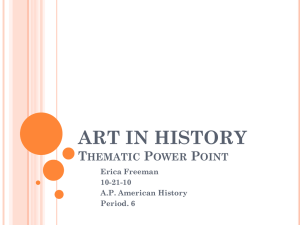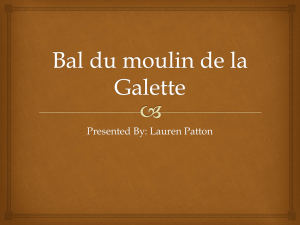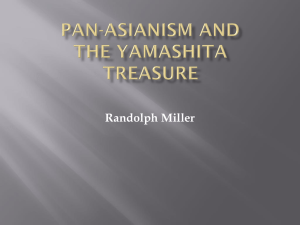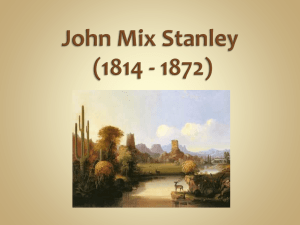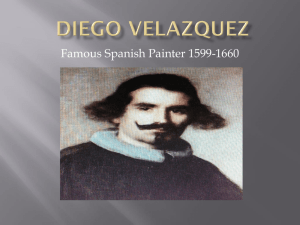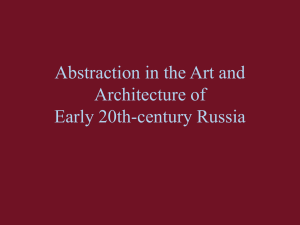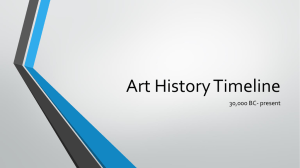Art (Part 5)
advertisement
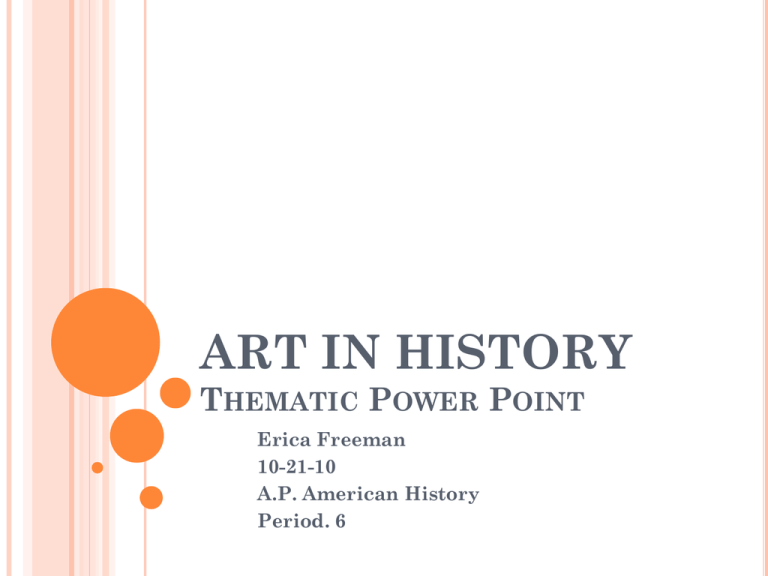
ART IN HISTORY THEMATIC POWER POINT Erica Freeman 10-21-10 A.P. American History Period. 6 CHAPTERS 1-3 MESOAMERICAN MAIZE CULTIVATION By an Aztec Artist In simple colors of almost no verity Shows a man using a tool to dig out a crop The man is only wearing a loin cloth Symbolizes that the peoples of Mesoamerica developed a grater verity of cultivated crops than any other region in the world This helped the civilization survive HUMAN FIGURES DANCING Painted on a piece of red-on-buff pottery Made by the Hohokams (1000 c.e.) The first irrigation farmers This piece of art work is a bowl type object Tribal like figures (dancing) are painted around it THEODOR DE BRY The New Queen Being Taken to the King Engraving by in the 16th century inspired by a drawing by Jacques le Moyne an early French colonist of Florida In this time period Florida communities were hierarchical, with classes and hereditary chiefs, some being women -In this engraving a “queen” is depicted being carried on an ornamental litter by men of rank A FRENCH PEASANT IN THE FIELD BEFORE A SPECTACULAR CASTLE Colorful Made in the 15th century The essayist Montaigne talked with several American Indians at the French court who “noticed among us some men gorged to the full with things of every sort while their other halves were beggars at their doors, emaciated with hunger and poverty” and “found it strange that these poverty stricken halves should suffer such injustice, and that they did not take the others by the throat or set fire to their houses.” This picture depicts the peasants working in the field and begging at the wall to a huge castle (not shown in this version) Above this a semi-circle with what seems to depict the time of year (it is in a different language) THE VICTIMS Struck Tenochtitlán Black and white 1520 Drawings of people dying from smallpox OF THE SMALLPOX EPIDEMIC “There came amongst us a great sickness, a general plague,” reads the account,” killing vast numbers of people. It covered many all over with sores: on the face, on the head, on the chest, everywhere… The sores were so terrible that the victims could not lie face down, nor on their backs, nor move from one side to the other. And when they tried to move even a little, they cried out in agony.” WATERCOLOR Jacques le Moyne 1564 Shows the Timucuas of coastal Florida and the colonists of the French colony of Fort Caroline having friendly relations The Timucuans had hoped that the French would help defend them against the Spanish who were in pursuit of Indian slaves This shows the Indians welcoming the French with a picnic of sorts THE ARMADA PORTRAIT OF ELIZABETH I Unknown artist 1648 Yellow tinted colors The queen has her hand on a globe Symbolizing the rising sea power of England The open windows in the background shows the battle against the Spanish Armada in 1588 and the destruction of the Spanish ships in a providential storm interpreted by the queen as an act of divine intervention THE ALGONQUIAN 1585 by John White Brown colors Shows VILLAGE OF eighteen longhouses surrounded by a palisaded enclosure with a guarded entrance (almost like a wall enclosure made of wood) The house with the pyramidshaped roof is thought to have been a ceremonial center POMEIOOC THE MASON CHILDREN Unknown Boston artist 1670 Puritan children David, Joanna and Abigail Mason They are dressed in finery An indication of wealth and prominence of their family The cane in David’s hand symbolizes his position as the male heir The rose in the hand of Abigail symbolizes childhood innocence THE EARLIEST KNOWN 1651 Now New York The Dutch intended to construct a fur trade network that extended far into the continent They paddle in dugout canoes 25 VIEW OF years after its founding, the Dutch settlement still occupied only the lower tip of Manhattan Island NEW AMSTERDAM TERMS Engraving the art of forming designs by cutting, corrosion by acids, a photographic process, etc., on the surface of a metal plate, block of wood, or the like, for or as for the purpose of taking off impressions or prints of the design so formed. Symbolism the practice of representing things by symbols, or of investing things with a symbolic meaning or character. Oil painting the process of painting with pigments that are bound with a medium of drying oil Watercolor The medium or the resulting artwork, in which the paints are made of pigments suspended in a water soluble vehicle. Pottery Ceramic ware, esp. earthenware and stoneware; objects that are first shaped of wet clay, and then hardened by baking. IMPORTANT PEOPLE Jacques le Moyne Jacques LeMoyne was a French artist who came to Florida with Rene de Laudonniere, a French explorer, in 1564. LeMoyne was the first artist to visit the new world. He traveled through North Florida, charting the coastline and the lives of the Timucua Indians. Theodor de Bry Theodor De Bry is best known for his series of volumes chronicling many of the earliest expeditions to the Americas. De Bry was a Frankfurt goldsmith, engraver, print-seller and book-seller. QUESTIONS 1. What is one example of symbolism in these forms of art listed above? The Mesoamericans farming b) The human figures on the pottery dancing c) The feast that the Timucuas prepared for the French d) The cane held by David Mason a) B 2. Who was the first artist to enter the New World? Theodor de Bry b) Leonardo Da Vinci c) Jacques le Moyne d) David Mason a) C 3. Who engraved famous artwork? Theodor de Bry b) Leonardo Da Vinci c) Jacques le Moyne d) David Mason a) A 4. What is engraving in the art world? The art of forming designs by cutting, corrosion, etc., on the surface of an object b) The art of carving totem poles c) A way to illustrate newspapers d) The art of forming designs by cutting patterns onto canvas a) A 5. How is pottery made? Shaped ceramic ware left out to dry b) Shaped ceramic ware that is never dried c) Shaped ceramic ware baked d) Shaped ceramic ware that is spun until dried a) C 6. What is done to the pigments on an oil painting? They are bound with drying oil b) They are bound with natural oils from an animal c) They are painted on the canvas first followed by a coat of oil d) They are painted on the canvas after a coat of oil is painted on a) A 7. What is done to the pigments in a watercolor? They are painted on the canvas first followed by a coat of water b) They are painted on the canvas after a coat of water is painted on c) They are suspended in water d) They are mixed in with water and oil a) C 8. What is the sickness that killed many in Tenochtitlán? Measles b) Chicken Pox c) Poison Ivy d) Small Pox a) D 9. In the painting of “The Mason Children” what does their clothing tell about them? They are poor b) They are wealthy c) They are settlers d) They are Indians a) B 10. In the earlier art the people are drawn in the fashion of what? Tribal b) Realistic c) Cartoon d) Animals a) A SOURCES Photos http://www.keyshistory.org/tumucanwedding2.jpg http://wwwdelivery.superstock.com/Image/4069/Thumb/4069-6984.jpg http://humanpast.net/images/Hohokam3.jpg http://upload.wikimedia.org/wikipedia/commons/8/88/Les_Tr%C3%A8s_Riches_Heures_du_du c_de_Berry_octobre_detail.jpg http://upload.wikimedia.org/wikipedia/commons/7/7d/FlorentineCodex_BK12_F54_smallpox.jp g http://upload.wikimedia.org/wikipedia/commons/f/fe/Elizabeth_I_Armada_Portrait_British_Sc hool.jpg http://www.virtualjamestown.org/images/white_debry/white_31_big.GIF http://www.steveartgallery.se/upload1/file-admin/images/new4/unknow%20artist-492773.jpg http://cache2.assetcache.net/xc/51246189.jpg?v=1&c=IWSAsset&k=2&d=45B0EB3381F7834DF603592FD303FF 231BCE97771A966A051786C2ED51971725 http://www.johnfishersr.net/images_fia/fia1987may.jpg Information http://dictionary.reference.com/browse/engraving http://dictionary.reference.com/browse/symbolism http://en.wikipedia.org/wiki/Oil_painting http://en.wikipedia.org/wiki/Watercolor_painting http://en.wikipedia.org/wiki/Pottery http://fcit.usf.edu/florida/lessons/lemoyne/lemoyne.htm http://www.philaprintshop.com/debry.html CHAPTERS 4-6 WHAT IS ART? Art is considered the product or process of deliberately arranging symbolic elements in a way that influences and affects the senses, emotions, and/or intellect. It encompasses a diverse range of human activities, creations, and modes of expression, including music literature film photography sculpture And paintings. Generally, art is made with the intention of stimulating thoughts and emotions. ART IN AFRICAN AMERICAN CULTURE FROM 1441 – 1770 Country born slaves provided development and evolution of their culture Molded themselves into new people This caused distinctive patterns in dance in music oral tradition They mostly did not have written literature which is a form of art Story telling Instead they had oral literature Created creative thoughts Led to telling the stories through painting, weaving, pottery etc. And in religion (death and burial) Decorated graves with shells and pottery old custom Dance was a form of worship ART IN AFRICAN AMERICAN CULTURE FROM 1441 – 1770 CONTINUED Dance and music Came before common language 18th century observers commented on the musical and rhythmic gifts of Africans Most Africans were accomplished at playing Banjo There style European violin Guitar They recreated instruments, that they used in Africa, in America Stringed instruments Drums Mastered the art of Thomas Jefferson African remembered their people as dancers, musicians and poets also Featured improvisation Rhythmic complexity Drums were outlawed due to fear that they were a secret way of communicating The slaves ended up using bones, spoons, or sticks Or just “patting juba” Slapping their thighs AFRICAN AMERICAN ART INFLUENCES Culinary arts Basket weaving Wood carving Architectural designs High, peaked roofs Broad, shady porches Ironworking Dance and music Influences back and forth between cultures TRADITIONAL CULTURE IN THE NEW WORLD DEALING WITH ART Oral cultures Depending on the transmission of information by the spoken word rather than through print story telling song music and other crafts Women could become involved in spinning LITERATURE IN COLONIAL AMERICA Literature was not primarily used as a form of entertainment but more as a way to inspire and inform others before the Enlightenment People like Benjamin Franklin created fictional characters to inform He used some entertainment in these writings but mostly that was not the main goal The Enlightenment Benjamin Franklin was quoted, “The culture of minds by the finer arts and sciences was necessarily postponed to times of more wealth and leisure… these times are come.” A rising demand for drama, poetry, essays, novels and history occurred Including William Shakespeare John Milton The essays of Joseph Addison Richard Steele Jonathan Swift Samuel Johnson And editions of the classics ART IN INDEPENDENCE In this time period literature was the main form of art Documents and quotes were used with descriptive language and use of literary symbolism For example: The Declaration of Independence is full is meaning behind the words and big language. Many say that this document was created to be read in turn by a large amount of people due to the music and pattern behind the words. ART IN INDEPENDENCE CONTINUED Famous works of art were also inspired by this time period Boston Massacre by Paul Revere This was a print, originally from a Boston Engraver Inaccurate by created much propaganda Such as The Battle of Bunker Hill by John Trumbull He was earned the title of “the Painter of the Revolution” TERMS Spinning: an ancient textile art in which plant, animal or synthetic fibers are twisted together to form yarn. Ironwork: Anything made of iron, or consists largely of it, especially when used for decoration Culinary Arts: the art of cooking. It is also a skill that is attained by study, practice, or observation related to the preparation of food Banjo: a stringed instrument with, typically, four or five strings, which vibrate a membrane of plastic material or animal hide stretched over a circular frame. Simpler forms of the instrument were fashioned by enslaved Africans in Colonial America, adapted from several African instruments of the same basic design. Literature: creative writing of recognized artistic value; the art of written works IMPORTANT PEOPLE John Trumbull: was an American artist during the period of the American Revolutionary War and was notable for his historical paintings. His Declaration of Independence (one of his paintings) was used on the reverse of the two-dollar bill. He was considered “the Painter of the Revolution” Benjamin Franklin: was one of the Founding Fathers of the United States. A noted polymath, Franklin was a leading author and printer, satirist, political theorist, politician, postmaster, scientist, inventor, civic activist, statesman, and diplomat. QUESTIONS 1. Who was “the Painter of the Revolution”? a) b) c) d) Benjamin Franklin Paul Revere John Milton John Trumbull D 2. What were African Americans widely described as? a) b) c) d) Musical Strong Not artistic Good painters A 3. How does Benjamin Franklin have anything to do with art a) b) c) d) He does not He was an inspired painter He owned slaves that were artistic He wrote creative literature D 4. What is spinning? a) b) c) d) Knitting A type of dancing Creating yarn Creating blankets C 5. How can ironwork be an art? a) b) c) d) It is not You can make designs You can paint with the melted iron You can make instruments and play them B 6. The Declaration of Independence is considered an art because a) b) c) d) It is a song It is not It has hidden meaning It is an painting C 7. In what time period did the arts become more in demand? a) b) c) d) The Enlightenment The Inspired time The War The Great Depression A 8. What is an example of instrument that the African Americans recreated? a) b) c) d) Violin Guitar Banjo Drumming C 9. Art includes a) b) c) d) Music Literature Painting All of the above D 10. How was art involved in burial a) b) c) d) They danced They decorated the graves They sang All of the above D SOURCES Photos http://phobos.ramapo.edu/~eshannon/AmericanSurvey1folder/SurveyIi mages/spinningwheel.jpeg http://www.elcivics.com/images/benjamin-franklin.jpg http://famouspoetsandpoems.com/pictures/john_trumbull.jpg http://www.earlyamerica.com/review/winter96/enlargement.html http://www.artinthepicture.com/artists/John_Trumbull/bunker.jpeg http://www.dv247.com/assets/products/37264_l.jpg Information http://en.wikipedia.org/wiki/Art http://www.picturesilove.com/ http://en.wikipedia.org/wiki/Spinning_(textiles) en.wiktionary.org/wiki/ironwork www.best-culinary-schools.info/culinary-definitions.html http://en.wikipedia.org/wiki/Banjo wordnetweb.princeton.edu/perl/webwn CHAPTERS 7-9 BENJAMIN WEST The first American to achieve artistic prominence in the artistic world of Europe Originally from Pennsylvania Left to England There he became popular as a painter of historical scenes Death of General Wolfe was one of his more acclaimed paintings Remained in England after the revolution JOHN SINGLETON COPLEY Originally from Boston Also moved to England This was due to his loyalist sentiments He was a portraitist His work was renowned for the truth and straightforwardness of his depictions He did a famous portrait of Samuel Adams Remained in England after the revolution GILBERT STUART Copley and West’s most promising student Fashionable style Portrait of Joseph Brant (Mohawk leader) Stuart returned to heroes in Philadelphia Eventually grew into a famous museum of curios, reflecting his interest in natural history, archaeology and exotic cultures The chaotic arrangement of exhibits was said to be like Peale’s Jeffersonian politics Part science part circus The collection was purchased by the pioneer American entertainer P.T. Barnum JOHN TRUMBULL From Connecticut Predicted America’s rise Went to Yale Served as a soldier in the Revolution Went to London to study with West Painted The Battle of Bunker Hill From that painting he made a series of revolutionary scenes He was concerned with documentary detail in his scenes of the birth of America ARCHITECTURE Nationalism was also present The greatest architectural project of the day was the new federal capital city Named for President Washington Jefferson, “Architecture is worth great attention as we double our numbers every twenty years, we must double our houses. It is, then, among the most important arts; and it is desirable to introduce taste into an art which shows so much.” ARCHITECTURE CONTINUED Asher Benjamin The Country Builder’s Assistant was a hand book written by him He was from New England Federal Style Restrained classicism He popularized an American variant of the Georgian style He emphasized the economy of decoration He recommended the use of indigenous materials Urban buildings were undertaken in the coastal cities during the shipping boom due to this restrained classicism POST REVOLUTION LITERATURE Higher demand for books Dictionaries Dramas Fictional based material Political TERMS Portraitist A person who makes portraits, especially a painter or photographer. Art exhibit traditionally the space in which art objects (in the most general sense) meet an audience Classicism The imitation or use primarily of the style and aesthetic principles of ancient Greek and Roman classical art and literature; in modern times, it also refers to the adoption of such principles in music. Federal-style architecture The name for the classicizing architecture built in the United States between c. 1780 and 1830, and particularly from 1785 to 1815. This style shares its name with its era, the Federal Period. Curios something (as a decorative object) considered novel, rare, or bizarre IMPORTANT PEOPLE Benjamin West An Anglo-American painter of historical scenes around and after the time of the American War of Independence. He was the second president of the Royal Academy in London. Asher Benjamin An American architect and author whose work transitioned between Federal style architecture and the later Greek Revival. His seven handbooks on design deeply influenced the look of cities and towns throughout New England until the Civil War. Builders also copied his plans in the Midwest and in the South. QUESTIONS 1. What was in higher demand after the Revolution? a) b) c) d) Paintings Books Maps Guns B 2. What was Benjamin West Famous for? a) b) c) d) Painting Writing books Playing music Singing A 3. What type of architecture was often used? a) b) c) d) There was no type, it was random Portraitist Nationalism Federal D 4. Who was Copley and West’s most promising student? a) b) c) d) Gilbert Stuart Asher Benjamin Joseph Brant John Trumbull A 5. What is a portraitist? a) b) c) d) A person who makes portraits of him/her self A person who is against the making of portraits A person who makes portraits, in general A person who makes portraits using only paint C 6. The Battle of Bunker Hill was painted by whom? a) b) c) d) Gilbert Stuart Jefferson Asher Benjamin John Trumbull D 7. Who was quoted about the reason why architecture was an important art? a) b) c) d) Washington Jefferson Asher Benjamin Benjamin West B 8. Who served as a soldier in the Revolution? a) b) c) d) Gilbert Stuart Asher Benjamin Joseph Brant John Trumbull D 9. Who was the first American to achieve artistic prominence in the artistic world of Europe a) b) c) d) Gilbert Stuart Asher Benjamin Benjamin West John Trumbull C 10. Who had a chaotic arrangement of exhibits? a) b) c) d) Gilbert Stuart Asher Benjamin Benjamin West John Trumbull A SOURCES Photos and Information http://www.thefreedictionary.com/portraitist http://en.wikipedia.org/wiki/Art_exhibition http://en.mimi.hu/architecture/classicism.html http://en.wikipedia.org/wiki/Federal_architecture http://www.merriam-webster.com/dictionary/curios http://en.wikipedia.org/wiki/Asher_Benjamin http://en.wikipedia.org/wiki/Benjamin_West http://en.wikipedia.org/wiki/File:The_death_of_gener al_warren_at_the_battle_of_bunker_hill.jpg http://en.wikipedia.org/wiki/Gilbert_Stuart http://en.wikipedia.org/wiki/John_Singleton_Copley CHAPTERS 10-12 AMERICAN ARTS AND LETTERS 1824-1840 The Age of the Common Man During Jackson’s Presidency There was a widespread interest in literature of all kinds This age was when American writers and painters found national themes This allowed them to produce the first distinctively American literature and other art types The spread of the written word The transportation revolution improved communication with different types of literature Rise in the number of newspapers, magazines and books The print revolution in 1826 helped the growth too Steamed power press AMERICAN ARTS AND LETTERS CON. American Culture in Art Philadelphia’s American Philosophical society Helped American art and literature Founded by Ben Franklin Famous authors Washington Irving James Fenimore Cooper Ralph Waldo AMERICAN ARTS AND LETTERS CON. Artists and Builders Artist were as successful as novelists in finding American Themes Famous Artists Thomas Cole Moved from England Was inspired by American landscapes Founded the Hudson River school of American painting Quote about him, “Every American is bound to prove his love country by admiring Cole.” Western Painters Karl Bodmer George Catlin Was driven by the need to document Indian life before it disappeared He spent 8 years among the tribes of the upper Missouri River His collection had 500 paintings He toured the country with this collection • To arouse public indignation about the western Indian nations • He was unsuccessful AMERICAN ARTS AND LETTERS CON. Western Painters Albert Bierstadt Thomas Moran John James Audubon Striking and grotesque etchings of American birds George Caleb Bingham Accomplished genre painter Produced tidied-up scenes of American workers Realists Romantics Drew on the dramatic western landscape and its people Their art was an important contribution to the American sense of land and to the nation’s identity They all were inspired to record and celebrate American life The most prevalent scene was the American wilderness Ironically this was endangered by the rapid western settlement AMERICAN ARTS AND LETTERS CON. Buildings Public building tended to be the monumental neoclassical style (with columns) This was also used with buildings that tried to produce a certain essence such as banks There were many odd building choices Mansions for southern plantations Medieval prisons America was not in a hurry to “build for the future” They mostly used a balloon-frame structure Basic frame of wooden studs fastened with crosspieces top and bottom Cheap Easy Quick Strong Somewhat insulated Housing for the common man and his family TERMS Steamed Power Press Realism was a complex artistic, literary and intellectual movement that originated in the second half of the 18th century in Europe, and gained strength in reaction to the Industrial Revolution. Neoclassical Architecture refers to the general attempt to depict subjects "in accordance with secular, empirical rules", as they are considered to exist in third person objective reality, without embellishment or interpretation. Romanticism a device for applying pressure and steam to an inked surface resting upon a print medium (such as paper or cloth), thereby transferring the ink tends to emphasize its planar qualities, rather than sculptural volumes. Projections and recessions and their effects of light and shade are flatter; sculptural bas-reliefs are flatter and tend to be enframed in friezes, tablets or panels Genre Painter Paints pictorial representations in any of various media that represent scenes or events from everyday life IMPORTANT PEOPLE Thomas Cole an English-born American artist. He is regarded as the founder of the Hudson River School, an American art movement that flourished in the mid-19th century George Catlin was an American painter, author and traveler who specialized in portraits of Native Americans in the Old West QUESTIONS 1. What did American’s mostly build for their homes? a) b) c) Balloon frame structures Neoclassical structures Mansions A 2. What does a genre painter paint? a) b) c) Paintings of a specific genre Paintings of a specific type of thing (i.e. all animals or all people) Everyday things C 3. What did Thomas Cole inspire? a) b) c) Landscape paintings Genre paintings Neoclassical architecture A 4. Did all homes looks almost uniformly the same? a) b) c) Yes No there were odd homes but most were similar There was never a typical home style B 5. What was a steamed power press used for? a) b) c) Making yarn Pressing cloth (ironing) Making print copies C 6. The age Age of the Common Man was during… a) b) c) Jackson’s presidency Jefferson’s presidency The end of slavery A 7. What were western painters known as? a) b) c) Realists Romantics Both C 8. What did Ben Franklin found? a) b) c) Virginia’s American Philosophical society Philadelphia’s American Philosophical society Massachusetts American Philosophical society D 9. What did George Catlin paint? a) b) c) Buildings Native Americans Landscapes B 10. The number of books ____ during this time period. a) b) c) Rose Fell Stayed the same A SOURCES Information http://en.wikipedia.org/wiki/Printing_press http://en.wikipedia.org/wiki/Genre_painter http://en.wikipedia.org/wiki/Neoclassical_architecture #Characteristics http://en.wikipedia.org/wiki/Romantics http://en.wikipedia.org/wiki/Realism_(arts) http://en.wikipedia.org/wiki/Thomas_Cole http://en.wikipedia.org/wiki/George_Catlin CHAPTERS 13-15 THE ANTEBELLUM PERIOD/ THE SECOND GREAT AWAKENING IN THE 1820’S- 1850’S Time when artistic movements occurred Writer’s works emphasized independence of individuals Walt Whitman Leaves of Grass (Book) Art was becoming more accepted into society The theater was becoming more popular Not considered a good job Hudson River School HUDSON RIVER SCHOOL CON. A school for landscape paintings (mostly made with oil paint) The best know native development of landscape art Influenced by Düsseldorf School of Painting Many Americans trained there Landscape art is a term that covers the depiction of natural scenery such as mountains, valleys, trees, rivers, and forests, and especially art where the main subject is a wide view, with its elements arranged into a coherent composition. HUDSON RIVER SCHOOL CON. A school like this had never been done in America before and it also introduced the Landscape style of painting. The works are now very valuable because the start of landscape painting and the start of this school is a huge step for art in America Art was much more common in other countries such as England The school was considered an “Art Movement” They portrayed the greatness of nature in America Themes of romanticism and Naturalism HUDSON RIVER SCHOOL CON. Began with the works of Thomas Cole (1801- 1848) Made the most impact • Revolutionized the styles, themes and methods of American Painting • Though he didn’t just impact America’s art he also revolutionized the worlds art form Did not have any formal education in art Derived ideas from poetry and literature Studied the landscapes of Thomas Doughty and Thomas Birch at the Pennsylvania Academy 1825 He sketched the Hudson river which brought him attention Traveled to Europe which made him better He expressed elevated moral tones and a concern with lofty themes He said that if nature was untouched by man then man could become more easily acquainted with God Asher B. Durand (1796- 1886) Next to Cole with importance Helped Cole revolutionize art With the death of Cole he was recognized as the new leader of American landscape paintings HUDSON RIVER SCHOOL CON. Hudson School’s Artists Thomas Doughty Thomas Chambers Jasper Francis Cropsey Albert Bierstadt John William Casilear Frederic Edwin Church Samuel Colman Asher Brown Durand Robert Duncanson Sanford Robinson Gifford James McDougal Hart William Stanley Haseltine Martin Johnson Heade Hermann Ottomar Herzog Thomas Hill David Johnson John Fredrick Kensett Jervis McEntee Thomas Moran Robert Walter Weir Worthington Whittredge HUDSON RIVER SCHOOL CON. Inspired by Artists in European countries Emerson Thoreau William Cullen Bryant Whitman They believed that art was A vehicle through which the universal mind could reach the mind of man kind an agent of moral and spiritual transformation TERMS Landscape a term that covers the depiction of natural scenery such as mountains, valleys, trees, rivers, and forests, and especially art where the main subject is a wide view, with its elements arranged into a coherent composition. In other works landscape backgrounds for figures can still form an important part of the work. Oil Painting Oil painting is the process of painting with pigments that are bound with a medium of drying oil Sketching a rapidly executed freehand drawing that is not intended as a finished work TERMS CON. Theater a branch of the performing arts. While any performance may be considered theatre, as a performing art, it focuses almost exclusively on live performers creating a self-contained drama Romanticism (art) a complex artistic, literary, and intellectual movement that originated in the second half of the 18th century in Europe, and gained strength in reaction to the Industrial Revolution. In part, it was a revolt against aristocratic social and political norms of the Age of Enlightenment and a reaction against the scientific rationalisation of nature, and was embodied most strongly in the visual arts, music, and literature, but had a major impact on historiography, education and natural history IMPORTANT PEOPLE Worthington Whittredge An American artist of the Hudson River School. He was a highly regarded artist of his time, and was friends with several leading Hudson River School artists including Albert Bierstadt and Sanford Robinson Gifford. He traveled widely and excelled at landscape painting, many examples of which are now in major museums. He served as president of the National Academy of Design from 1874 to 1875. Albert Bierstadt A German-American painter best known for his large, detailed landscapes of the American West. In obtaining the subject matter for these works, Bierstadt joined several journeys of the Westward Expansion. Though not the first artist to record these sites, Bierstadt was the foremost painter of these scenes for the remainder of the 19th century. QUESTIONS 1. Sketching is… a) b) c) A drawing that takes a lot of time A drawing that takes a short amount of time A fully detailed and completed work of art B 2. Who had the most impact to landscape painting in America? a) b) c) Thomas Cole Albert Bierstadt Asher B. Durand A 3. What was the first landscape painting school in America? a) b) c) Manhattan River School The Düsseldorf School of Painting Hudson River School C 4. Was American art advanced at this time period? a) b) c) Yes No In the middle B 5. What Period did artistic movement occur (1820s1850s)? a) b) c) The Antebellum Period The Second Great Awakening They are the same C 6. Literature stressed the ______ of individuals. a) b) c) Independence Dependence Changes A 7. Art in this time was MOST influenced by a) b) c) The discoveries of new lands Poetry and Literature Scientific discoveries A 8. What is oil Painting? a) b) c) Process of painting with pigments that are bound with a medium of animal fat Process of painting with pigments that are bound with a medium of drying oil Process of painting with pigments that are mixed with a medium of suspended oil B 9. Did Romanticism further advance art? a) b) c) Yes No, it stayed the same No, it made us work rather than be involved with art (it reversed the art advancement) A 10. What is a landscape painting? a) b) c) A painting of an individual A painting with a wide view A painting of architecture B SOURCES Information http://www.exampleessays.com/viewpap er/13918.html http://www.artchive.com/artchive/C/cole .html http://www.pbs.org/wnet/ihas/icon/huds on.html http://en.wikipedia.org/wiki/Landscape_ art http://en.wikipedia.org/wiki/List_of_Hu dson_River_School_artists CHAPTERS 16 AND 17 A NEW MEDIUM OF PHOTOGRAPHY AND ARTWORK Conveyed the of war with gruesome reality to the American public Regarded as the first major war that was “observed” by the public It is called this because of the fact that the public could see what the battle and life of the soldiers was like from photographs and other artwork While a battle was going on artists used photography rather than other forms of art but this was not too common The available artwork of battle scenes is mostly from an artist’s memory to complete a sketch or imagination A NEW MEDIUM OF PHOTOGRAPHY AND ARTWORK CON. Special Artists Painting and sketching was usually used by artists to depict the daily life of the soldiers Families were greatly concerned with the fate of their sons This meant that there was a need for journalists and artists to report and depict these soldiers lives These people did not usually survive Newspapers sold in great numbers At any moment there were about 12 special artists Low numbers due to: danger of the job and they had to be fast and accurate sketchers ART IN THE SOUTH Not very well known for their art Publish work but mostly ignored Lost art due to the destruction of homes AFRICAN AMERICANS IN ART South Carolina legislation in 1865 Provided that, “no person of color shall pursue or practice the art, trade, or business of an artisan, mechanic, or shopkeeper, or any other trade employment, or business, besides that of husbandry, or that of a servant under contract for service or labor” without a special and costly permit. In 1867 The promise of radical reconstruction brought forth African American’s with useful skills such as literacy This time period’s paintings depicted blacks as their freedom and lives progressed Artists usually tried to get their paintings accurate with the time period that they were painting The most common paintings started with black being depicted as slaves, then runaways, then freedom and then African Americans being successful with their lives African Americans as artists There were already few freed slaves that had become artists by this time period There work was almost undistinguishable from white works This was due to the fact that their audience and commissions were predominantly white TERMS Photography Derives from the Greek words phōs (genitive: phōtós) light, and gráphein, to write. The word was coined by Sir John Herschel in 1839.A camera obscura box used for drawing images. Photography is the result of combining several different technical discoveries. Sketching a rapidly executed freehand drawing that is not intended as a finished work Artisan a skilled manual worker who makes items that may be functional or strictly decorative, including furniture, clothing, jewelry, household items, and tools. Literacy Traditionally described as the ability to read and write. It is a concept claimed and defined by a range of different theoretical fields. Commission (In art) the hiring and payment for the creation of a piece, often on behalf of another IMPORTANT PEOPLE Robert S. Duncanson Was born in Seneca County, New York in 1821. Duncanson’s father was a Canadian of Scottish descent and his mother was an African American, thus making him “a freeborn person of color.” Duncanson, an artist who is relatively unknown today, painted America, both physically and figuratively, at a time when the country was in turmoil. He is said to be the first free professional black artist. He was also a Hudson River School painter Edward Lamson Henry One of the country's most popular and prolific genre artists at the end of the nineteenth century QUESTIONS 1. Who was Robert S. Duncanson? a) b) c) The first free professional black artist A popular genre artist A “special artist” A 2. Who was Edward Lamson Henry? The first free professional black artist b) A popular genre artist c) A “special artist” a) B 3. What was a special artist? a) b) c) An artist who paints only a certain thing An artist with special needs An artist who sketches battle scenes C 4. What was the difference between African American artwork and white art work in this time period? The African American artwork depicted the freedom of slaves b) The African American artwork depicted their harsh life c) There was minimal differences a) C 5. Did the 1865 South Carolina legislation make it easy for African Americans to become skilled in an art? a) b) c) Yes, it ended the racism towards the African Americans in the art world Yes, it made it easier by providing a trade school for the blacks No, it made them pay for a permit to do such things C 6. What does Commission mean in terms of art? a) b) c) The hiring and payment for the creation of a piece, often on behalf of another The hiring and payment for the creation of a piece for one’s self The hiring and payment for the creation of a piece that is designed fully by the buyer A 7. Art in the South was...? a) b) c) Valued as important by the countries art community Virtually unrecognized Just as famous as northern art B 8. What is literacy? a) b) c) Another term for an author The ability to read Learning to read B 9. Did the Hudson school accept African Americans? a) b) c) No, the 1865 South Carolina legislation did not allow them No, It was a white skinned only school Yes C 10. What is a reason why the southern art work was not as well known? a) b) c) They did not produce artwork A lot of the art was destroyed The north sabotaged them for being better artists B SOURCES Information http://www.askart.com/askart/interest/civil_wa r_art_1.aspx?id=40 http://en.wikipedia.org/wiki/History_of_photog raphy http://en.wikipedia.org/wiki/Commission_(art) http://en.wikipedia.org/wiki/Literacy http://en.wikipedia.org/wiki/Artisan http://en.wikipedia.org/wiki/Edward_Lamson_ Henry http://en.wikipedia.org/wiki/Robert_Scott_Dun canson
